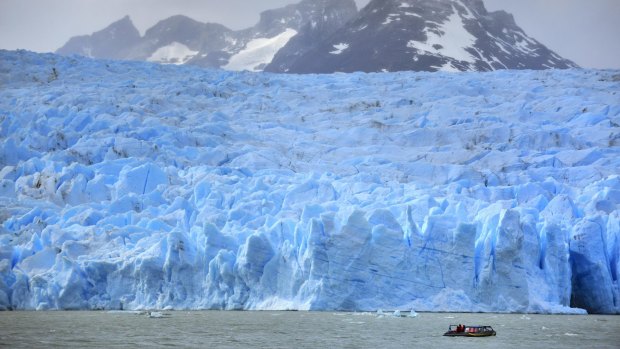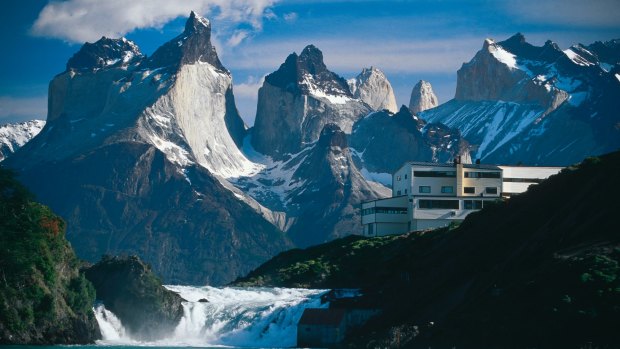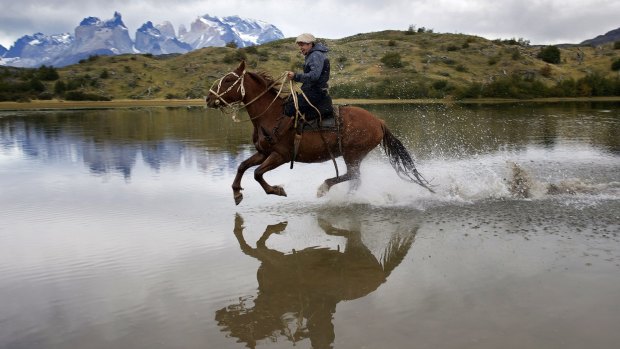This was published 7 years ago
Patagonia and Torres del Paine: Like nothing else on Earth
By Isobel King

Patagonia glacier.Credit: KATSUYOSHI TANAKA
It became the running puma gag. With an estimated 50 or so of these mountain lions in Torres del Paine national park, we figured the chance of a sighting was about as remote as this southern tip of the Americas. A couple of our group returned from a photographic expedition brandishing close-ups of pumas on their phones, the wide grins giving away the certainty of a fake.
The rest of us had headed off on a hike along the plains at the eastern boundary of the park, where our guides assured us the wildlife was prolific. Indeed, we saw great herds of guanacos – a llama-like native of South America and tasty bait for pumas – darting hares, and at one point we were almost encircled by playful foxes. On the way back to the hotel, our keen-eyed driver spotted an echidna, which we tumbled out of the van to catch a glimpse of. But no puma.
Then on a hike, one of the guides casually pulls out his phone and hands it to me. I watch as shaky footage follows a puma loping down the stepped boardwalk that leads from our main lodge down to the lakeside guides' quarters and spa area, seemingly unfazed by the person shadowing him. "Dylan [one of the guides] captured that on his phone," he says matter-of-factly. It was the trump card that silenced the cynics – and certainly made me think twice about that outdoor jacuzzi we'd been happily soaking in.

Torres del Paine, Patagonia.Credit: Explora
Our lodgings are Explora's Hotel Salto Chico, in the very heart of Torres del Paine, 242,000 hectares of geological and glacial magnificence in Chile's wedge of Patagonia. From virtually every vantage point of the hotel – including my bedroom and bathroom– soaring glass windows offer a panoramic view up Lake Pehoe to the snow-capped spectacle beyond.
The Cordillera del Paine, or Paine Massif, is the crowning centrepiece of the park, a cluster of jagged peaks and sandwiched rock formations thrown up from Earth's belly some 12 million years ago, then slowly worn down by glacial erosion. There's the sharp granite spires of the three towers or "torres", which give the park its name; flanked by giant Paine Grande; and the black-tusked horns of Los Cuernos, its dark base and tips sandwiching a white band of granite.
The Paine Massif is the home of the famous W trek, which some tackle in one marathon slog, and others break into manageable one-day hikes. The bite-sized chunks are among the offering at Explora, a hotel that attracts a predominantly 50-to-70-year-old age group who want their wilderness experience tempered with a bit of luxury. Interestingly, excursions manager Rodrigo Diaz tells me that Australians, after the US market, make up the biggest proportion of guests. I also hear about the now-legendary 89-year-old who has been returning to Explora every season, almost since the hotel opened in 1993, to indulge his love of horse riding under the expert care of the hotel's gauchos.

In high season, the popular treks can book out quickly.Credit: Explora
The advice is to dip your toe in the water with a couple of half-day hikes or horse rides, so you have a gauge of your fitness level and stamina. It also provides a benchmark that the guides can then use to advise on the difficulty level of other walks. The hotel has about 40 excursions, each day's offering geared for the conditions and guest demand. Groups are limited to a maximum of eight people, and the excursions are decided the night before in consultation with the guides and a large map that sets out all the designated trails. There's much discussion, as guides delicately navigate the path between gentle encouragement and subtle reality checks. In high season, the popular treks can apparently book out quickly, so punctuality for the evening sessions is advised.
Our early-May visit was outside the park's peak summer season, so we more often than not had two guides, even with a small group; one for the fast eddys and one for the leisurely hikers, so no one felt pressured to keep up and there was plenty of opportunity to soak up the guides' vast knowledge of the park and take photos. It was cold – a bracing minus 2 degrees on my first morning amble around the shores of Grey Lake, its steely grey hue stained by glacial rock flour suspended in the water. My nose and fingertips felt as blue as the drifting icebergs on the glacial lake. Someone's camera shutter wouldn't open; apparently batteries can seize up in the cold.
But there were major upsides to visiting Patagonia's arguably most spectacular national park in the colder months. There were none of the notorious winds that plague the area in summer; up to 150km/h freaks of nature that sheer off the sides of trees. I saw plenty of those. We were assured we'd struck unseasonably clear conditions for the time of year: blue skies every day, not a drop of rain, hardly any cloud cover to spoil the views, and lakes like glass, unruffled by blistering gusts. And what remaining tracts of native lenga forest there are after the devastating 2011 fire, which destroyed almost 17,000 hectares of the park, were autumnal orange and red.
But even the wizened forest has its charm. On the very easy half-day hike to see the turquoise waters of Nordenskjold Lake (it's the amount of suspended rock flour that dictates the colour of the glacial lakes, I learn), we hike through the silvery silhouettes of dead lenga to the sound of cracking avalanches. Five years on from the fire, started by a careless tourist at the beginning of peak season, the landscape has taken on a new patina; the stark stretches of absent forest only accentuate the magnificence of snow-capped mountain ranges, glacial lakes, rivers and streams.
The compulsory hike for me was the one-day walk to see Grey Glacier, on the edge of the vast Southern Patagonia icefield. It stretches north to south for 370 kilometres and encompasses about 50 major glaciers, most of which have been retreating at an alarming rate in the past decade or so. Such grim news brings on a sense of urgency.
It's one of the easier strands of the W trek. The trip kicks off in Explora's catamaran, crossing Lake Pehoe in perishingly cold temperatures. A handful braves the deck for photos while the rest of us huddle inside. The trail on the other side begins with a moderate ascent that soon deposits you on a high point overlooking glass-like Laguna Los Patos, mountains in every direction. It's impressive, especially in the early morning light, but turns out to be a warm-up for the big reveal: that first, breathtaking moment you arrive at the elevated Grey Lake lookout that stares straight down the lake, dotted with icebergs, to Grey Glacier and the dense icefield beyond. It's the third-largest ice sheet in the world, after Antarctica and Greenland, and it seems to stretch into frozen infinity.
Out of nowhere I hear the words a jaded traveller once said to me, "everywhere begins to look like somewhere else", and realise with great satisfaction, he's wrong. I've never seen anything like this.
We get the chance to take in the view at leisure, as we stop for lunch on the rocky ledge that is apparently packed in summer. Today we have it to ourselves, enjoying the spread the guides have carried in their hefty backpacks, including hot soup and the novel offering of coffee served with Baileys Irish Cream from a hip flask.
The track then descends as it traces the lake, each bend revealing a closer perspective on the glacier. We're in the area where the 2011 fire started, the transition between charred tree spines and thick autumnal lenga forest. I realise how magnificent the park must have been before the fire.
Eventually, we reach the spot where the commercial boat picks us up, full of passengers who have opted for the laid-back excursion to Grey Glacier, and together we cruise in close to the glacier, shards of pale blue towering above us. The whole day has been a teasing lead-up to this finale and even the bitter cold can't keep me inside this time.
A picture flashes to mind. It's a slide that we're shown on our introductory briefing at Explora: a gargantuan mass of blue (that's ocean) swallowing a tiny wisp of white (that's land). It's Patagonia's latitude, shared by no other land mass at its base of the globe: a wild, barely populated wilderness. Today, I've seen the tip of the iceberg.
LAN Airlines operates daily flights between Sydney and Santiago via Auckland. Australian citizens pay a reciprocity fee of $US117 on arrival in Santiago. It's then a 3½-hour flight with LATAM Airlines to Punta Arenas, in Chilean Patagonia. From there, it's about a four-hour drive to Torres del Paine. See www.latam.com
STAYING THERE
The Explora Hotel Salto Chico is an all-inclusive, 50-room hotel on the shores of Lake Pehoe (all meals and beverages, daily excursions and airport transfers included). Four-night packages from $2640 a person, double occupancy (winter season). See www.explora.com
South America Tourism Office offers a range of Patagonia tours, starting from $1440 a person for the five-day Remota Patagonia. See southamericatourism.com
Isobel King travelled courtesy of South America Tourism Office and LATAM Airlines
Sign up for the Traveller Deals newsletter
Get exclusive travel deals delivered straight to your inbox. Sign up now.